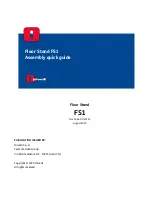
5. Secure the mounting base to the wall, using at least
two field-supplied screws. See Figure 3.
Figure 3: Route the cable from behind and mount the wall
plate
Note:
When you bring the cable through the
wall, seal the cable opening. If left unsealed,
the hole allows air from outside the room into
the transmitter and affects the measurement
readings. For example, fresh concrete binds CO
2
and can cause low readings, especially in new
buildings.
Connecting the cable to the mounting
base
About this task:
Connect the wires from the cable to the screw terminals
on the mounting base. The terminal assignments are
marked next to the screw terminals. Maximum wire size is
2 mm
2
, AWG 14.
1. Strip 1/4 in. (6.35 mm) of insulation from the ends
of the power and output signal wires.
Note:
To prevent a short circuit, make sure that
the wires are stripped to the correct length
and fully inserted into the terminal blocks. If
using shielded cable, ensure that the shield is
protected from contact with components on the
top or bottom side of the printed circuit board.
Failure to follow proper wiring procedures may
cause the transmitter to fail.
2. Connect the wires to the mounting base screw
terminals as shown in Figure 4.
Figure 4: Screw terminals
Note:
The transmitter generates both voltage
and current output. Each output has its own
individual positive screw terminal.
Power supply requirements
The transmitter requires a 24 VAC/VDC, Class 2 power
supply. Although the power input includes a halfwave
rectifier, use a DC supply to avoid excessive current peaks.
Connections to a 24 VAC power supply
Connecting more than one transmitter to a single 24 VAC
transformer forms a common loop and increases the risk
of a short circuit. To prevent this, use a separate floating
supply for each transmitter. See Figure 5.
Figure 5: Connecting separate AC supplies
If several transmitters share a common transformer,
always connect the transmitter common to the same
side of the transformer to maintain the polarity. A shared
common line at the controller can cause a short circuit if
the phase is not the same. See Figure 6.
CD-W00-x0-2 Series Wall Mount CO
2
and Temperature Transmitters Installation Guide
3




























